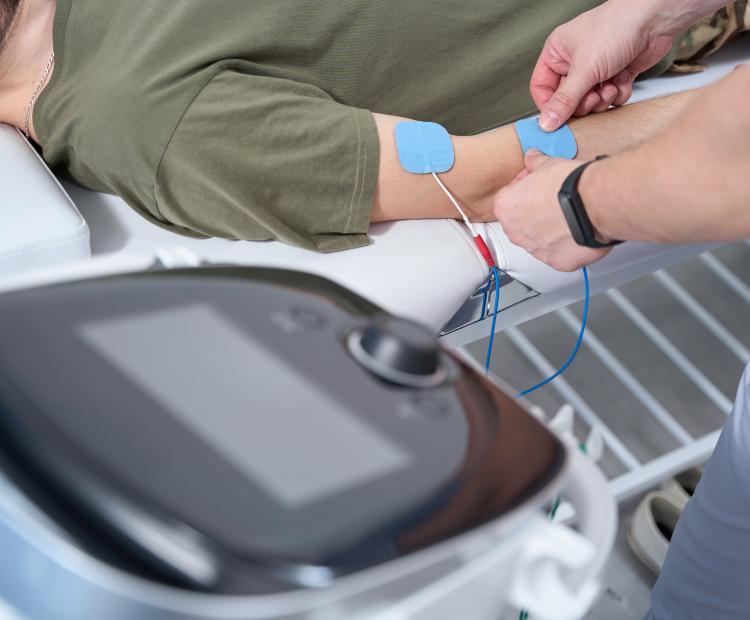Electromyography tests (EMG) are a type of electrodiagnostic test that helps doctors assess the function of the muscles and nerves in your body. It may be recommended if nerve or muscle disorder symptoms appear, such as numbness and tingling in your extremities, pain, or muscle weakness.
An EMG test is often conducted alongside an NCV nerve conduction study to measure the function of peripheral nerves outside the brain and spinal cord.
Before an EMG is performed, a healthcare provider will discuss how to prepare for the procedure, what is involved during the test, and what the test results may mean.
The guide below provides more information on what to expect from an EDX test, including whether or not the procedure is painful.
What is an EMG Test?
An EMG measures the response of your muscles to the electrical stimulation sent from your brain. This can be used to evaluate how well your muscles and the nerves that control them function.
When you move, your nerves send electrical signals to the muscles. An EMG helps identify problems with your muscles, nerves, or the signals between them.
An EMG test and a NCV nerve conduction study may be performed in the same setting and on the same day, but they are different diagnostic tests. Combining EMG tests and nerve conduction studies can help determine the full health of nerve and muscle functionality.
Are EMG Tests Painful?
Although every patient experiences their own pain tolerance, EMG and NCV tests typically do not cause significant pain. However, it is possible to experience some mild discomfort or minor pinching sensations when the small needle electrode is inserted into the muscle or the nerves being stimulated but small amounts of electricity.
Once the test is finished, removing the fine needles usually does not cause pain.
.png)
Why is an EMG Test Recommended?
EMG diagnostic procedures are often performed when a patient is experiencing certain symptoms related to muscle dystrophy disorders, including:
Symptoms of nerve root injury
Nerve root problems may develop if the nerves become compressed or damaged in the spine. When a nerve in the spine is damaged, it can lead to symptoms such as:
- Pain in your neck, back, and limbs
- Weakness in your muscles
- Tingling or numbness in your muscles
Suspected muscle degeneration
Muscle degeneration is a condition characterized by muscle tissue wasting away. Several conditions can lead to muscle degeneration, including amyotrophic lateral sclerosis (Lou Gehrig's disease), various forms of muscular dystrophy, and myasthenia gravis.
Symptoms of muscle degeneration may include:
- Decreased muscle size
- Increased muscle weakness
- Balance issues
Nerve compression issues
Nerve compression develops when a nerve is compacted or
squeezed. This may include a pinched nerve in the extremities, limbs, and torso. For example, carpal tunnel syndrome, which affects the nerves in the wrist, is one of the most common types of nerve compression disorders. Symptoms of nerve compression may include the following:
- Weakness in the affected area
- Pins and needles feeling in the affected area
- Difficulty moving a limb
A study published in Neurology1 found that most of the 250 patients surveyed reported feeling mild to no pain after an EMG test.
How Can You Make an EMG Test Less Painful?
It is helpful to know what to expect before any type of EDX test to avoid discomfort, including EMGs.
Prior to the test, discuss any concerns you have with a doctor. They may provide specific instructions to ease the EMG process, including taking over-the-counter pain medication, such as Tylenol.
After the procedure, it may also help to take over-the-counter pain relievers or apply ice to the sore area to relieve discomfort. However, always follow the physician's instructions for aftercare, Including how to reduce pain.
How Long Does an EMG Procedure Take?
The time it takes to complete an EMG/NCV nerve test may vary depending on the extent of a patient's symptoms. Usually, an EMG test takes about 30 minutes to an hour to complete. In most cases, an EMG examines several muscles and nerves. The test may take longer if more nerves are being evaluated.
Is the Recovery After an EMG Test Painful?
Recovery from an EMG test is usually not painful. However, minor muscle soreness may occur for a day or two following the procedure.
Typically, over-the-counter pain medication is sufficient to treat discomfort. The doctor may also provide additional instructions after the procedure to treat any pain.
Are There Any Risks to Having an EMG Test?
Although an EMG is considered low-risk, there is always a risk of possible side effects. Mild discomfort can develop, but severe pain after an EMG test is unlikely.
The risks of an EMG test are generally not serious. Possible risks include the following:
- Lymphedema: This involves swelling of the soft tissues.
- Skin infection: Although uncommon, it is possible to develop a skin infection near the needle insertion site. Following proper post-procedure instructions can help reduce this risk.
- Bruising: Some patients may develop temporary swelling and bruising at the needle puncture site. Ice can be applied to reduce bruising.
What Do Your Results of an EMG Test Mean?
Your doctor will discuss your EDX results after your test. Average EMG and NCV results with muscle response and electrical activity within the normal range generally indicate normal muscle and nerve function.
If your EMG test is abnormal, it may indicate signs of peripheral neuropathy, nerve damage, or myopathy. Your doctor will discuss abnormal test results with you, determine if additional testing is needed, and discuss treatment options.
Summary
An EMG procedure is generally not painful. However, some people may feel mild discomfort. An EMG can help diagnose various conditions, including injuries and diseases that affect the nerves and muscles in the body.
If you have any questions about an EMG procedure or an NCV nerve conduction study, we are happy to help. To schedule a consultation, contact us online or call us at 480-573-0130
today.
References
- Paiz, F., Midroni, G., & Kassardjian, C. (2022). Patient-reported pain experience during nerve conduction studies and needle electromyography (P1-1. Virtual). Neurology, 98(18_supplement), 2651. https://www.neurology.org/doi/10.1212/WNL.98.18_supplement.2651
- Log in to post comments

